Research - (2020) Advances in Dental Surgery
Knowledge, Awareness, and Attitude Towards Importance of Finishing and Polishing used of Composite Restorations
Ahmed Hilal Sheriff K and Manish Ranjan*
*Correspondence: Manish Ranjan, Department of Conservative Dentistry and Endodontics, Saveetha Dental College and Hospitals, Saveetha Institute of Medical and Technical Science, Saveetha University, Chennai, India, Email:
Abstract
Critical clinical procedures during restoration of the teeth include proper finishing and polishing of dental restoratives, they are especially important for the esthetics and longevity of restorations. Residual surface roughness of restorations can influence dental biofilm retention, resulting in superficial staining, gingival inflammation, and secondary caries, which leads to affecting the clinical performance of restorations. Thus, the aim of the study is to determine the level of knowledge, awareness, and practice among the dental students regarding the importance of Finishing and polishing of composite restoration. The questionnaire consisting of 10 questions was prepared online and the link was distributed to the dental students to fill the survey. The data was imported to SPSS software for statistical analysis, chi square test was done. Association between gender distribution and awareness among the students if finishing and polishing of composite restorations are mandatory, shows 23% of males and 39% of females agreed it was mandatory. Association between gender distribution and awareness among the students if type of composite plays a vital role in color stability, both males (29%) and females (44%) agreed that type of composite plays a vital role. Association between gender distribution and finishing and polishing being done by the students, both males (36%) and females (49%) practiced finishing and polishing of composite for the patients in their practice. These associations did not show statistical significance. The use of Composite restorations in the field of dentistry has become extremely popular and most preferred type of restorations among the patients. Importance of awareness regarding new techniques in dentistry should be emphasized to the future dental practitioners.
Keywords
Composite, Microfilled, Polishing, Surface roughness
Introduction
Resin composite materials are the most modified and improved restorative material in dentistry, which was introduced by Bowen et al. [1]. Despite all initial inherent problems, the current status of composite restorations used in conjunction with the total acid-etch technique has made many dentists choose these materials, even for restoring areas of high occlusion stress, such as posterior teeth [2,3]. Enormous esthetic demands have led the dentists to adopt the resin composite restorations in routine dental practice [4]. Surface roughness of the dental restorations remains a striking problem associated with the use of direct composite resins [5] which increases plaque retention resulting in gingival inflammation, superficial discoloration, and secondary caries. On the contrary, smooth, highly polished restorations are shown to be less susceptible to plaque accumulation and extrinsic discoloration; bear improved mechanical properties [6].
Critical clinical procedures during restoration of the teeth include proper finishing and polishing of dental restoratives, they are especially important for the esthetics and longevity of restorations. Residual surface roughness of restorations can influence dental biofilm retention, resulting in superficial staining, gingival inflammation, and secondary caries, which leads to affecting the clinical performance of restorations [7–10]. However, to achieve a highly polished surface of composites is difficult, because of factors such as different amounts of filler particles, the size of particles and the differences in hardness between the filler particles and matrix of the resin composite. It is believed that the polishing ability of composites vary depending on particle size [11] and microfilled resin composites are more easily polished than hybrid types. The smoothest possible surface is obtained when the resin composite polymerizes against a Mylar matrix without subsequent finishing or polishing [12,13]; however, such a surface has a resin-rich layer, poor mechanical properties, is susceptible to increased wear and discoloration and should be eliminated [6,14]. In addition, in clinical situations, most restorations need to be adjusted to their final shape. Thus, finishing and polishing of restorations are crucial.
It has been reported by Jones et al. [15] that a surface roughness of 0.3 mm can be detected by the tip of the patient’s tongue. Proper contour, smoothness and high gloss can produce the desired results of natural tooth structure desired by patients [16]. A rougher surface texture can lead to decreased gloss and increased discoloration of the material surface which can affect the final results of the restorations and esthetics [17,18]. Therefore, it is of paramount importance to obtain smooth and glossy surfaces. Variables, such as resin composite type, resin monomer, concentration and type of filler particles, the finishing/polishing system used, all influence the final surface polish of resin composites.
A wide variety of finishing and polishing systems with dissimilar compositions, abrasives and shapes are commercially available. Their effects might differ among the resin composites and also there might be variations between the systems which could impact the final surface texture. When different techniques are proposed, not only their efficiency in maintaining a smooth surface but also their ability to obtain a gloss surface have to be considered. It is known that gloss measurement is an additional parameter to roughness while evaluating the effectiveness of polishing [19].
We have numerous highly cited publications on well-designed clinical trials and lab studies [20– 34]. This has provided the right platforms for us to pursue the current study. Various studies have been to determine the awareness level of dental students [35,36]. Dental students need to have a better understanding regarding the various tools or assistive measures which aid in diagnosis and a successful treatment. Thus the aim of the study is to determine the level of knowledge, awareness and practice among the dental students regarding the importance of Finishing and polishing of composite restorations.
Materials and Methods
A questionnaire consisting of 10 questions were prepared and distributed to 100 dental students to assess their knowledge, awareness, and practice towards the importance of finish and polishing of composite resins. The questionnaire was prepared online, and the link was distributed to the dental students to fill the survey. The questionnaire contained close ended and few multiple-choice questions about basic knowledge and awareness on the importance of finishing and polishing composite resins and practice of the same. The results were tabulated in Microsoft Excel and was imported in SPSS software for statistical analysis. Chi square tests were done with significance level at 5%.
Questionnaire
Do you think polishing of composite restorations is mandatory?
In your opinion, does the type of composite play a vital role in color stability?
Is color stability of significant concern while providing composite restorations?
Is polishing paste required?
Polishing of composite restoration influences the colour stability over a period.
Finished restoration offers high esthetics, longevity of restorations and maximal oral health.
Rough surfaces of the restorations are more likely to cause?
Do you finish & polish composite restorations in your practice?
Do you use Polishing kit/Polishing burs?
Difficulty level of polishing direct anterior composite restoration?
Results and Discussion
Completed questionnaires were returned by all the participants giving a response rate of 100%. Results of our study can be analysed as follows. Figure 1 shows association between gender distribution and awareness among the students if finishing and polishing of composite restorations are mandatory, shows 23% of males and 39% of females agreed it was mandatory. This association was statistically not significant, Chi square value -0.573 and p value is 0.449. Association between gender distribution and awareness among the students if type of composite plays a vital role in color stability, both males (29%) and females (44%) agreed that type of composite plays a vital role. This association was statistically not significant, Chi square value -0.008 and p value -0.927 as seen in Figure 2. From Figure 3 association between gender distribution and awareness among the students if color stability is a significant concern shows both males (32%) and females (55%) agreed that color stability is significant. This association was statistically not significant, Chi square value -2.888 and p value-0.89. The association between gender distribution and awareness among the students if polishing paste is required shows that both males (20%) and females (32%) felt the need of polishing paste during the procedure however there was an equal distribution of agreement and disagreement among the male students in this aspect. This association was statistically not significant, Chi square value -0.107 and p value- 0.744 as seen in Figure 4. Figure 5 shows the association between gender distribution and awareness among the students regarding the influence of polishing on color stability, both males (22%) and females (36%) felt that polishing influences color stability of composite restoration and this association was statistically not significant, Chi square value -0.246 and p value -0.620. The association between gender distribution and knowledge among the students regarding finished restoration and its results shows that both males (32%) and females (52%) agreed that finished restorations offer longevity, high esthetics andand offer better results. This association was statistically not significant, Chi square value -0.794 and p value -0.373 as seen in Figure 6.
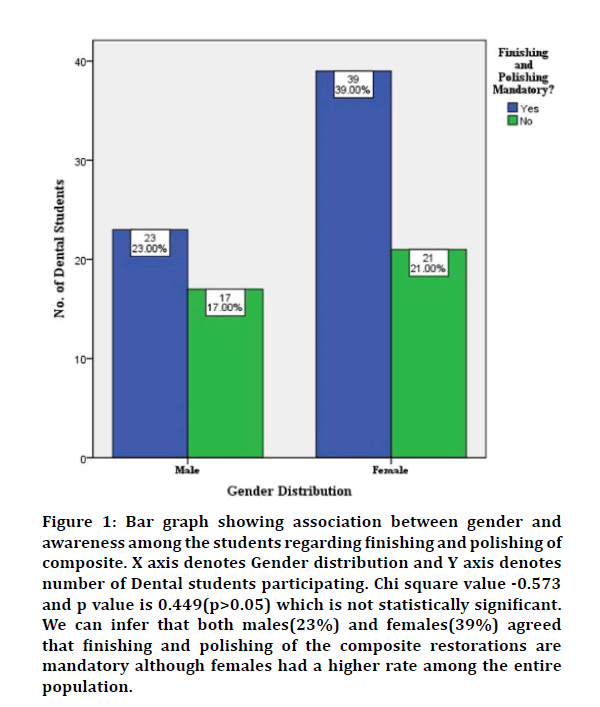
Figure 1: Bar graph showing association between gender and awareness among the students regarding finishing and polishing of composite. X axis denotes Gender distribution and Y axis denotes number of Dental students participating. Chi square value -0.573 and p value is 0.449(p>0.05) which is not statistically significant. We can infer that both males(23%) and females(39%) agreed that finishing and polishing of the composite restorations are mandatory although females had a higher rate among the entire population.
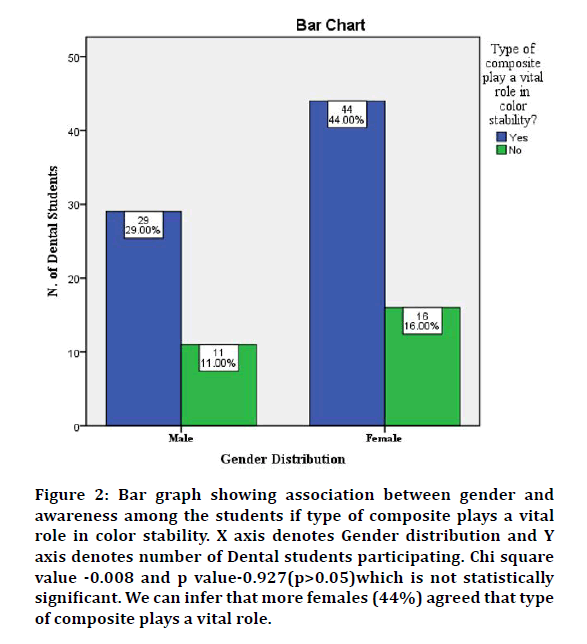
Figure 2: Bar graph showing association between gender and awareness among the students if type of composite plays a vital role in color stability. X axis denotes Gender distribution and Y axis denotes number of Dental students participating. Chi square value -0.008 and p value-0.927(p>0.05)which is not statistically significant. We can infer that more females (44%) agreed that type of composite plays a vital role.
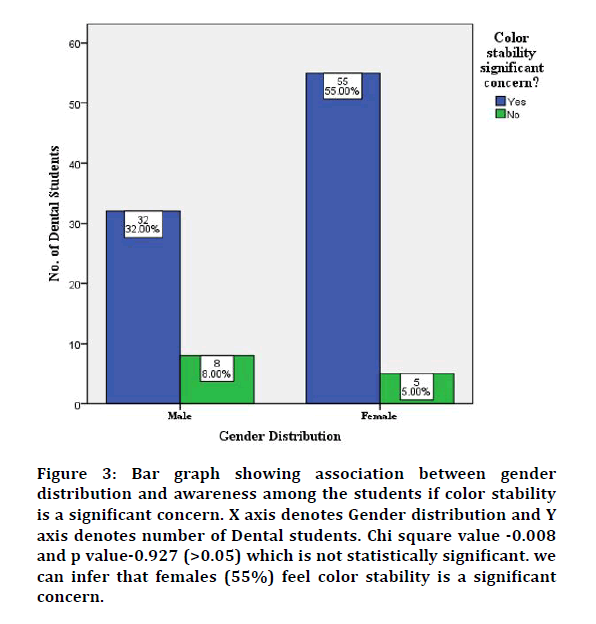
Figure 3: Bar graph showing association between gender distribution and awareness among the students if color stability is a significant concern. X axis denotes Gender distribution and Y axis denotes number of Dental students. Chi square value -0.008 and p value-0.927 (>0.05) which is not statistically significant. we can infer that females (55%) feel color stability is a significant concern.
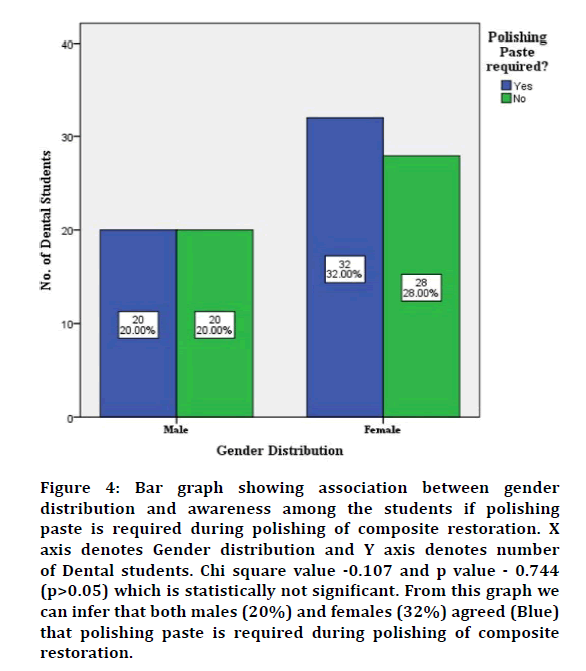
Figure 4: Bar graph showing association between gender distribution and awareness among the students if polishing paste is required during polishing of composite restoration. X axis denotes Gender distribution and Y axis denotes number of Dental students. Chi square value -0.107 and p value - 0.744 (p>0.05) which is statistically not significant. From this graph we can infer that both males (20%) and females (32%) agreed (Blue) that polishing paste is required during polishing of composite restoration.
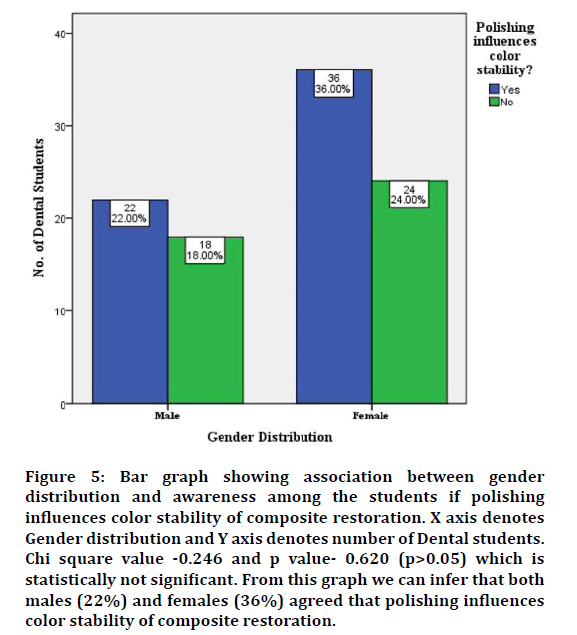
Figure 5: Bar graph showing association between gender distribution and awareness among the students if polishing influences color stability of composite restoration. X axis denotes Gender distribution and Y axis denotes number of Dental students. Chi square value -0.246 and p value- 0.620 (p>0.05) which is statistically not significant. From this graph we can infer that both males (22%) and females (36%) agreed that polishing influences color stability of composite restoration.
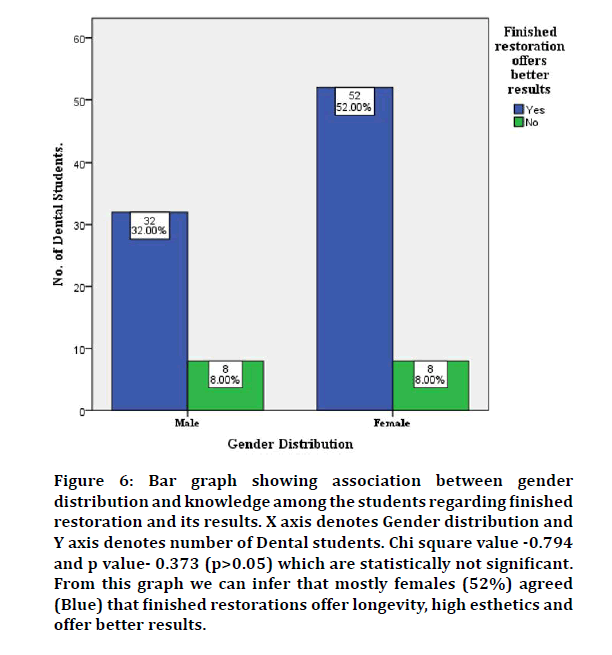
Figure 6: Bar graph showing association between gender distribution and knowledge among the students regarding finished restoration and its results. X axis denotes Gender distribution and Y axis denotes number of Dental students. Chi square value -0.794 and p value- 0.373 (p>0.05) which are statistically not significant. From this graph we can infer that mostly females (52%) agreed (Blue) that finished restorations offer longevity, high esthetics and offer better results.
Figure 7 shows association between gender distribution and knowledge among the students regarding surface irregularities both males (23%) and females(42%) felt that all the listed options above(Violet) would be the result of surface irregularities of a composite, i.e, retention of plaque, fracture of the restoration and eventually compromises the restoration that finished restorations offer longevity, high esthetics and offer better results. This association was statistically not significant, Chi square value -3.787 and p value- 0.285. Association between gender distribution and finishing and polishing being done by the students, both males (36%) and females (49%) agreed that finishing and polishing of composite is routinely done for the patients in their practice and this association was statistically not significant, Chi square value -1.307 and p value- 0.253 as seen in Figure 8. Figure 9 shows association between gender distribution and methods of finishing and polishing being done by the students, finishing and polishing burs are mostly being used by the dental students (31% & 44% among males and females respectively) while dedicated polishing kits are being used only by few students (9% and 16% among males and females respectively) and this association was statistically not significant, Chi square value -0.222 and p value- 0.637. Association between gender distribution and difficulty levels of finishing and polishing anterior restoration, both males (27%) and females (47%) have suggested that finishing and polishing of anterior restoration is difficult and this association was statistically not significant, Chi square value -2.141 and p value- 0.343 as seen in Figure 10.
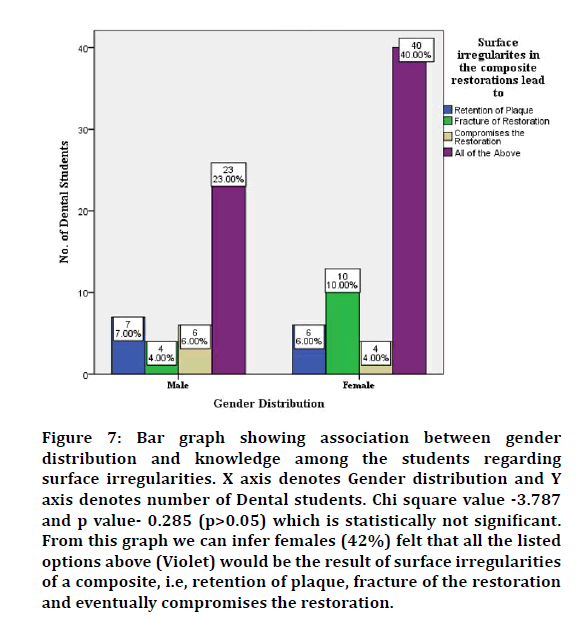
Figure 7: Bar graph showing association between gender distribution and knowledge among the students regarding surface irregularities. X axis denotes Gender distribution and Y axis denotes number of Dental students. Chi square value -3.787 and p value- 0.285 (p>0.05) which is statistically not significant. From this graph we can infer females (42%) felt that all the listed options above (Violet) would be the result of surface irregularities of a composite, i.e, retention of plaque, fracture of the restoration and eventually compromises the restoration.
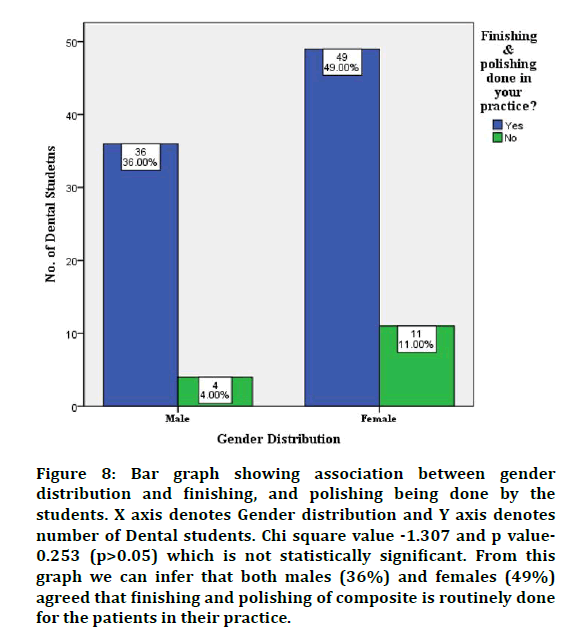
Figure 8: Bar graph showing association between gender distribution and finishing, and polishing being done by the students. X axis denotes Gender distribution and Y axis denotes number of Dental students. Chi square value -1.307 and p value- 0.253 (p>0.05) which is not statistically significant. From this graph we can infer that both males (36%) and females (49%) agreed that finishing and polishing of composite is routinely done for the patients in their practice.
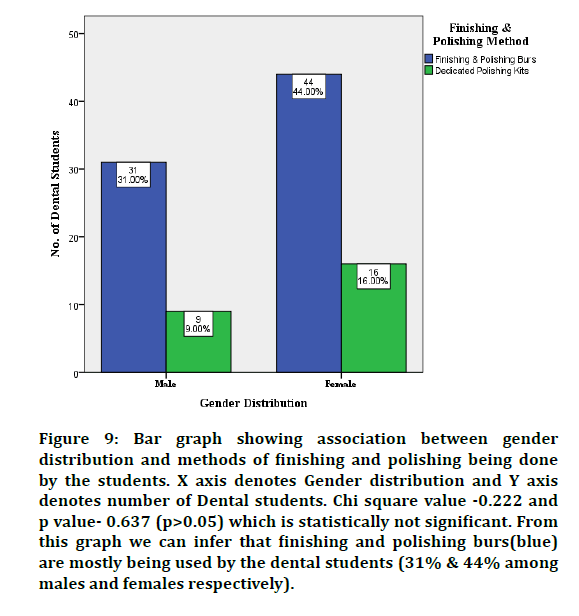
Figure 9: Bar graph showing association between gender distribution and methods of finishing and polishing being done by the students. X axis denotes Gender distribution and Y axis denotes number of Dental students. Chi square value -0.222 and p value- 0.637 (p>0.05) which is statistically not significant. From this graph we can infer that finishing and polishing burs(blue) are mostly being used by the dental students (31% & 44% among males and females respectively).
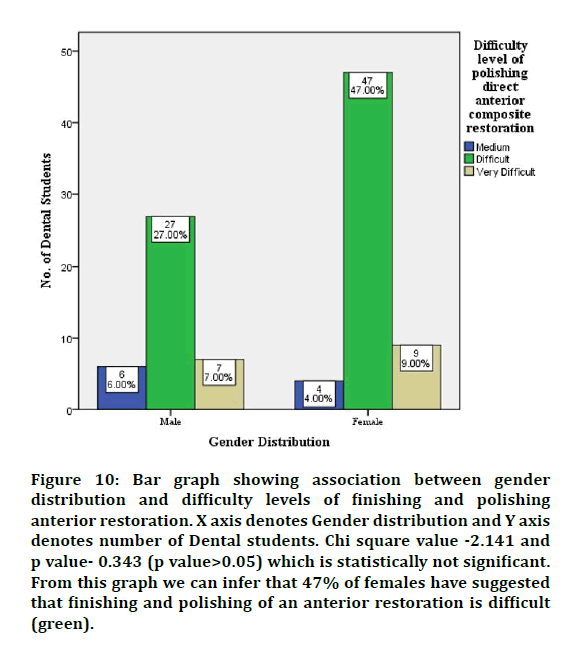
Figure 10: Bar graph showing association between gender distribution and difficulty levels of finishing and polishing anterior restoration. X axis denotes Gender distribution and Y axis denotes number of Dental students. Chi square value -2.141 and p value- 0.343 (p value>0.05) which is statistically not significant. From this graph we can infer that 47% of females have suggested that finishing and polishing of an anterior restoration is difficult (green).
Finishing and polishing of resin composite restorations are critical steps to enhance the esthetics and longevity of restored teeth [37]. Poorly polished restorations are susceptible to surface discoloration, plaque buildup, gingival irritation, and recurrent caries [38]. The surface quality of resin composite restorations is associated with the polishing quality along with its inborn physical properties like volume, hardness, quantity of filler particles and organization of the resin matrix [39]. Most of the respondents (23% of males and 39% of females) felt that it is mandatory to do finishing and polishing of the composite restorations after direct composite placement as seen in Figure 1.
Color stability of the composite resin materials is related to type of the composite resin restorative materials and polishing procedures [40]. In agreement with this, 29% of males and 44% of females among the dental students as seen in figure 2, expressed that the type of composite plays a vital role in color stability. Various studies have concluded that staining or discoloration was one of the primary reasons for replacement of composite restorations [41]. Similarly from figure 3, 32% of males and 55% of female respondents claimed that color stability is of significant concern while providing composite restorations and 20% of males and 32% of the female respondents felt it is essential to use polishing paste during polishing procedure as seen in figure 4, these results were corroborating with a survey done by Al Qarni et al. [42]. Sen et al. [43] reported that the polishing pastes provided a smoother surface effectively and it has been reported that use of polishing paste after the use of polishing disks significantly decreased staining in comparison to the use of polishing disks alone, for all types of composites [40]. Various studies has been done which stated that color stability of the composite resin over a period of time is influenced by the polishing procedure and among the respondents in our study 22% of males and 36% of females agree to this fact.
High-quality finishing and polishing of composites are important steps to enhance both the esthetics and longevity of restored teeth [44,45]. In accordance with this statement as seen in figure 6, 32% of males and 52% of females among the respondents felt polishing of the composite restorations provides longevity of restoration and optimal oral health. Unfortunately, polishing is complicated by the heterogeneous nature of these dental materials, i.e., hard filler particles embedded in a relatively soft matrix. Composite surface roughness is basically dictated by the size, hardness, and amount of filler which influences the mechanical properties of the resin composites. Surface irregularities can lead to staining, high wear rates, plaque retention, gingival irritation, and recurrent caries [46,47]. From figure 7, 23% of males and 42% of female students were also aware of this fact. Conversely, a high degree of smoothness and low surface porosity decrease the adherence of agents responsible for changing the color of composite resins, such as dental biofilms, tobacco, and food colorants [48]. Therefore, it is especially important that dental restorations are polished to delay the discoloration and aging processes of composite resins.
Figure 8 reveals that 36% of males and 52% of females among the dental students involved in this survey were positively employing finishing and polishing of the composite restorations routinely for their patients. Color stability of the composite resin materials is related to the type of composite resin and polishing procedures. Manufacturers provide a variety of instruments to accomplish finishing and polishing, such as diamond rotary cutting instruments, carbide burs, abrasive-impregnated rubber cups and points, abrasive disks and polishing pastes. Different types of composites call for different polishing techniques and various studies have reported that dedicated polishing systems and procedures are needed to create the kind of surface smoothness that prevents early discoloration [10,43]. Most of the respondents (31% of males and 44% of female) are using fine diamond polishing burs whereas only a few students among the respondents (9% of males and 16% of female) use dedicated polishing kits as seen in figure 9. This method of using finishing and polishing burs must not be used by the dentists when dedicated polishing kits are available in the market, as they are available for the sole purpose of polishing composite restorations and which may yield better esthetic results comparatively. When dentists perform anterior composite restorations, the selection of materials and equipment, including the type of composite, the type of adhesive system, and the kind of light curing unit, may influence mechanical properties and ultimately affect clinical performance [49,50]. From figure 10 we can see that the dental students who attempted this survey revealed that polishing of anterior restorations are difficult (27% males and 47% females), this may be because of several reasons like esthetic replication, anatomy of the anterior teeth and also maybe due to the lack of instruments/materials among the students. Several different composites are available in the market, including: microfilled composites, providing a more polishable surface; hybrid composites jointing resistance and smooth surface; and more recently the composites with nanofillers, offering several advantages over the previously available composites [51–53].
This study consisted of a limited number of students and it was found that most of the female students had the knowledge and awareness regarding the importance of finishing and polishing of composite restorations. To ascertain the results of this study and to increase the level of significance, future studies with a larger sample size must be conducted.
Conclusion
The use of Composite restorations in the field of dentistry has become extremely popular and most preferred type of restorations among the patients. There are various case reports and pre-clinical studies which show the benefits and outcomes of the finishing and polishing of the composite restorations. Within the limitation of this study, it was found that female participants were more aware regarding the importance of finishing and polishing of composite restorations. Most of the dental students reportedly use finishing and polishing burs which may be due to the lack of knowledge and awareness regarding the polishing kits. Therefore it is necessary to impose the importance regarding the new techniques in dentistry and must be emphasized to create more awareness to the future dental practitioners.
Acknowledgement
The authors are thankful to Saveetha Dental college for providing a platform to express our knowledge.
Conflict of Interest
The authors declare no conflict of interest.
References
- Bowen RL. Dental filling material comprising vinyl silane treated fused silica and a binder consisting of the reaction product of bis phenol and glycidyl acrylate. United States Patent 1962; 3:112.
- Leinfelder KF. Posterior composites. State-of-the-art clinical applications. Dent Clin North Am 1993; 37:411–418.
- Lopes B. Direct posterior resin composite restorations: Considerations on finishing/polishing. Clinical Procedures Quinten Int 2004; 35:359–366.
- Brackett WW, Gilpatrick RO, Gunnin TD. Effect of finishing method on the microleakage of Class V resin composite restorations. Am J Dent 1997; 10:189–191.
- Senawongse P, Pongprueksa P. Surface roughness of nanofill and nanohybrid resin composites after polishing and brushing. J Esthet Restor Dent 2007; 19:265–273.
- Gordan VV, Patel SB, Barrett AA, et al. Effect of surface finishing and storage media on bi-axial flexure strength and microhardness of resin-based composite. Oper Dent 2003; 28:560–567.
- Yap AU, Lye KW, Sau CW. Surface characteristics of tooth-colored restoratives polished utilizing different polishing systems. Oper Dent 1997; 22:260-265.
- Hoelscher DC, Neme AML, Pink FE. The effect of three finishing systems on four esthetic restorative materials. Operative Dent 1998; 23:36-42.
- Setcos JC, Tarim B, Suzuki S. Surface finish produced on resin composites by new polishing systems. Quintessence Int 1999; 30.
- Reis AF, Giannini M, Lovadino JR. The effect of six polishing systems on the surface roughness of two packable resin-based composites. Am J Dent 2002; 15:193-197.
- Strassler H. Polishing composite resins to perfection depends on the filler. Dent Off 1990; 10:9–10.
- Ergücü Z, Türkün LS. Surface roughness of novel resin composites polished with one-step systems. Oper Dent 2007; 32:185–192.
- Janus J, Fauxpoint G, Arntz Y, et al. Surface roughness and morphology of three nanocomposites after two different polishing treatments by a multi technique approach. Dent Mater 2010; 26:416–425.
- Ergücü Z, Türkün LS, Aladag A. Color stability of nanocomposites polished with one-step systems. Oper Dent 2008; 33:413–420.
- Jones CS, Billington RW, Pearson GJ. The in vivo perception of roughness of restorations. Br Dent J 2004; 196:42–45.
- Cenci MS, Venturini D, Pereira-Cenci T, et al. The effect of polishing techniques and time on the surface characteristics and sealing ability of resin composite restorations after one-year storage. Oper Dent 2008; 33:169–176.
- Sakaguchi RL, Douglas WH, DeLong R, et al. The wear of a posterior composite in an artificial mouth: A clinical correlation. Dent Mater 1986; 2:235–240.
- Lu H, Roeder LB, Lei L, et al. Effect of surface roughness on stain resistance of dental resin composites. J Esthet Restor Dent 2005; 17:102–108.
- O’Brien WJ, Johnston WM, Fanian F, et al. The surface roughness and gloss of composites. J Dent Res 1984; 63:685–688.
- Ramamoorthi S, Nivedhitha MS, Divyanand MJ. Comparative evaluation of postoperative pain after using endodontic needle and EndoActivator during root canal irrigation: A randomised controlled trial. Australian Endodont J 2015; 41:78–87.
- Ramanathan S, Solete P. Cone-beam computed tomography evaluation of root canal preparation using various rotary instruments: An in vitro Study. J Contemp Dent Pract 2015; 16:869–872.
- Siddique R, Sureshbabu NM, Somasundaram J, et al. Qualitative and quantitative analysis of precipitate formation following interaction of chlorhexidine with sodium hypochlorite, neem, and tulsi. J Conserv Dent 2019; 22:40–47.
- Rajakeerthi R, Ms N. Natural product as the storage medium for an avulsed tooth-A systematic review. Cumhuriyet Dent J 2019; 22:249–256.
- Rajendran R, Kunjusankaran RN, Sandhya R, et al. Comparative evaluation of remineralizing potential of a paste containing bioactive glass and a topical cream containing casein phosphopeptide-Amorphous calcium phosphate: An in Vitro Study. Pesquisa Brasileira Em Odontopediatria Clínica Integrada 2019; 19:1–10.
- Hussainy SN, Nasim I, Thomas T, et al. Clinical performance of resin-modified glass ionomer cement, flowable composite, and polyacid-modified resin composite in noncarious cervical lesions: One-year follow-up. J Conserv Dent 2018; 21:510–515.
- Kumar D, Antony S. Calcified canal and negotiation-A review. Research J Pharma Technol 2018; 11:3727–3730.
- Ravinthar K. Recent advancements in laminates and veneers in dentistry. Res J Pharm Technol 2018; 11:785–787.
- Noor S. Chlorhexidine: Its properties and effects. Res J Pharma Technol 2016; 9:1755–1760.
- Teja KV, Ramesh S, Priya V. Regulation of matrix metalloproteinase-3 gene expression in inflammation: A molecular study. J Conserv Dent 2018; 21:592–596.
- Janani K, Palanivelu A, Sandhya R. Diagnostic accuracy of dental pulse oximeter with customized sensor holder, thermal test and electric pulp test for the evaluation of pulp vitality: an in vivo study. Brazilian Dent Sci 2020; 23:8.
- Jose J, Subbaiyan H. Different treatment modalities followed by dental practitioners for ellis class 2 fracture–A questionnaire-based survey. Open Dent J 2020; 4.
- Teja KV, Ramesh S. Shape optimal and clean more. Saudi Endodontic J 2019; 9:235.
- Manohar MP, Sharma S. A survey of the knowledge, attitude, and awareness about the principal choice of intracanal medicaments among the general dental practitioners and nonendodontic specialists. Indian J Dent Res 2018; 29:716.
- Nandakumar M, Nasim I. Comparative evaluation of grape seed and cranberry extracts in preventing enamel erosion: An optical emission spectrometric analysis. J Conserv Dent 2018; 21:516–520.
- Gopalasamy K, Ranjan M. Knowledge, awareness and perception of cention being used as a replacement for amalgam restoration. Int J Res Pharma Sci 2020; 11:7–12.
- Choudhari S, Ranjan M. Knowledge, awareness, and perception regarding occlusal stamp technique for composite restorations. Drug Invention Today 2019; 11.
- Quirynen M, Marechal M, Busscher HJ, et al. The influence of surface free energy and surface roughness on early plaque formation. An in vivo study in man. J Clin Periodontol 1990; 17:138–144.
- Strassler HE, Bauman G. Current concepts in polishing composite resins. Pract Periodontics Aesthet Dent 1993; 5:12–17.
- Takanashi E, Kishikawa R, Ikeda M, et al. Influence of abrasive particle size on surface properties of flowable composites. Dent Mater J 2008; 27:780–786.
- Güler AU, Güler E, Yücel AC, et al. Effects of polishing procedures on color stability of composite resins. J Appl Oral Sci 2009; 17:108–112.
- Kroeze HJ, Plasschaert AJ, van ’t Hof MA, et al. Prevalence and need for replacement of amalgam and composite restorations in Dutch adults. J Dent Res 1990; 69:1270–1274.
- Al Qarni MA, Togoo RA, Shahrani A. Finishing and polishing procedures of composite restorations by Saudi dentists: A cross-sectional study. J Contemporary Dent Practise 2013; 14:657–661.
- Sen D, Göller G, Işsever H. The effect of two polishing pastes on the surface roughness of bis-acryl composite and methacrylate-based resins. J Prosthet Dent 2002; 88:527–532.
- Türkün LS, Türkün M. The effect of one-step polishing system on the surface roughness of three esthetic resin composite materials. Oper Dent 2004; 29:203–211.
- Başeren M. Surface roughness of nanofill and nanohybrid composite resin and ormocer-based tooth-colored restorative materials after several finishing and polishing procedures. J Biomater Appl 2004; 19:121–134.
- Dunkin RT, Chambers DW. Gingival response to class V composite resin restorations. J Am Dent Assoc 1983; 106:482–484.
- Yap AUJ, Mok BYY. Surface finish of a new hybrid aesthetic restorative material. Oper Dent 2002; 27:161–166.
- Vichi A, Ferrari M, Davidson CL. Color and opacity variations in three different resin-based composite products after water aging. Dent Materials 2004; 20:530–534.
- Baldissera RA, Corrêa MB, Schuch HS, et al. Are there universal restorative composites for anterior and posterior teeth? J Dent 2013; 41:1027–1035.
- Moura FRR de, Romano AR, Lund RG, et al. Three-year clinical performance of composite restorations placed by undergraduate dental students. Braz Dent J 2011; 22:111–116.
- Moraes RR, Goncalves L de S, Lancellotti AC, et al. Nanohybrid resin composites: nanofiller loaded materials or traditional microhybrid resins? Oper Dent 2009; 34:551–557.
- Saunders SA. Current practicality of nanotechnology in dentistry. Part 1: Focus on nanocomposite restoratives and biomimetics. Clin Cosmet Investig Dent 2009; 1:47–61.
- Ferracane JL. Resin composite-State of the art. Dent Mater 2011; 27:29–38.
Author Info
Ahmed Hilal Sheriff K and Manish Ranjan*
Department of Conservative Dentistry and Endodontics, Saveetha Dental College and Hospitals, Saveetha Institute of Medical and Technical Science, Saveetha University, Chennai, IndiaCitation: Ahmed Hilal Sheriff K, Manish Ranjan, Knowledge, Awareness, and Attitude Towards Importance of Finishing and Polishing used of Composite Restorations, J Res Med Dent Sci, 2020, 8 (7): 48-56.
Received: 15-Sep-2020 Accepted: 14-Oct-2020 Published: 21-Oct-2020
